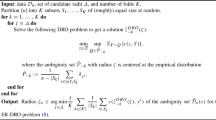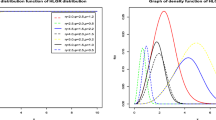Abstract
Application of the copulas can be useful for the accurate multivariate frequency analysis of hydrological phenomena. There are many copula functions and some methods were proposed for estimating the copula parameters. Since the copula functions are mathematically complicated, estimating of the copula parameter is an effortful work. In the present study, an optimization-based method (OBM) is proposed to obtain the parameters of copulas. The usefulness of the proposed method is illustrated on drought events. For this purpose, three commonly used copulas of Archimedean family, namely, Clayton, Frank, and Gumbel copulas are used to construct the joint probability distribution of drought characteristics of 60 gauging sites located in East-Azarbaijan province, Iran. The performance of OBM was compared with two conventional methods, namely, method of moments and inference function for margins. The results illustrate the supremacy of the OBM to estimate the copula parameters compared to the other considered methods.





Similar content being viewed by others
References
Chen L, Singh VP, Guo S, Mishra AK, Guo J (2013a) Drought Analysis Using Copulas. J Hydrol Eng 18(7):797–808
Chen YD, Zhang Q, Xiao M, Singh VP (2013b) Evaluation of risk of hydrological droughts by the trivariate Plackett copula in the East River basin (China). Nat Hazards 68(2):529–547
De Michele C, Salvadori G (2003) A Generalized Pareto intensity-duration mode of storm rainfall exploiting 2-Copulas. J Geophys Res 108(D2):4067
Fan YR, Huang WW, Huang GH, Huang K, Li YP, Kong XM (2015) Bivariate hydrologic risk analysis based on a coupled entropy-copula method for the Xiangxi River in the Three Gorges Reservoir area. China Theor Appl Climatol. doi:10.1007/s00704-015-1505-z
Frahm G, Junker M, Schmidt R (2005) Estimating the tail-dependence coefficient: properties and pitfalls. Insur Math Econ 37(1):80–100
Fu G, Butler D (2014) Copula-based frequency analysis of overflow and flooding in urban drainage systems. J Hydrol 510:49–58
Ganguli P, Reddy MJ (2013) Probabilistic assessment of flood risks using trivariate copulas. Theor Appl Climatol 111(1–2):341–360
Genest C, Favre AC (2007) Everything you always wanted to know about copula modeling but were afraid to ask. J Hydrol Eng 12(4):347–368
Genest C, Rémillard B (2004) Tests of independence based on the empirical copula process. TEST 13(2):335–369
Genest C, Rémillard B (2008) Validity of the parametric bootstrap for goodness-of-fit testing in semiparametric models. Ann Inst H Poincaré Probab Statist 44(6):1096–1127
Genest C, Rivest LP (1993) Statistical inference procedures for bivariate Archimedean copulas. J Am Stat Assoc 88(423):1034–1043
Genest C, Ghoudi K, Rivest LP (1995) A semiparametric estimation procedure of dependence parameters in multivariate families of distribution. Biometrika 82(3):543–552
Genest C, Quessy JF, Rémillard B (2006) Local efficiency of a Cramér-von Mises test of independence. J Multivar Anal 97:274–294
Genest C, Rémillard B, Beaudoin D (2009) Goodness-of-fit tests for copulas: A review and a power study. Insur Math Econ 44(2):199–213
Hassanzadeh Y, Abdi A, Talatahari S, Singh VP (2011) Meta-heuristic algorithms for hydrologic frequency analysis. Water Resour Manag 25(7):1855–1879
Joe H (1997) Multivariate models and dependence concepts. Chapman and Hall, New York
Kaveh A, Behnam AF (2013) Charged system search algorithm for the optimum cost design of reinforced concrete cantilever retaini walls. Arab J Sci Eng 38:563–570
Kaveh A, Talatahari S (2010a) A novel heuristic optimization method: Charged system search. Acta Mech 213(3–4):267–289
Kaveh A, Talatahari S (2010b) A charged system search with a fly to boundary method for discrete optimum design of truss structures. Asian J Civ Eng 11(3):277–293
Kaveh A, Talatahari S (2011) Geometry and topology optimization of geodesic domes using charged system search. Struct Multidisc Optim 43:215–229
Kaveh A, Talatahari S (2012) Charged system search for optimal design of frame structures. Appl Soft Comput 12:382–393
Kaveh A, Talatahari S, Farahmand Azar B (2012) Optimum design of composite open channels using charged system search algorithm. IJST Trans Civ Eng 36(C1):67–77
Lee T, Modarres R, Ouarda TBMJ (2013) Data-based analysis of bivariate copula tail dependence for drought duration and severity. Hydrol Process 27(10):1454–1463
McKee TB, Doesken NJ, Kleist J (1993) The relationship of drought frequency and duration to time scales. In: 8th Conference on Applied Climatology, 17–22 January, Anaheim, CA, pp, pp. 179–184
Mirabbasi R, Anagnostou EN, Fakheri-Fard A, Dinpashoh Y, Eslamian S (2013) Analysis of meteorological drought in northwest Iran using the Joint Deficit Index. J Hydrol 492:35–48
Mirabbasi R, Fakheri-Fard A, Dinpashoh Y (2012) Bivariate drought frequency analysis using the copula method. Theor Appl Climatol 108(1–2):191–206
Nazemi A, Elshorbagy A (2012) Application of copula modelling to the performance assessment or reconstructed watersheds. Stoch Environ Res Risk Assess 26(2):189–205
Nelsen RB (2006) An introduction to copulas. Springer, New York
Özyön S, Temurtaş H, Durmuş B, Kuvat G (2012) Charged system search algorithm for emission constrained economic power dispatch problem. Energy 46:420–430
Poulin A, Huard D, Favre A, Pugin S (2007) Importance of tail dependence in bivariate frequency analysis. J Hydrol Eng 12(4):394–403
Rauf UFA, Zeephongsekul P (2014) Copula based analysis of rainfall severity and duration: a case study. Theor Appl Climatol 115:153–166
Reddy MJ, Ganguli P (2012a) Application of copulas for derivation of drought severity-duration-frequency curves. Hydrol Process 26(11):1672–1685
Reddy MJ, Ganguli P (2012b) Bivariate flood frequency analysis of upper Godavari river flows using Archimedean copulas. Water Resour Manag 26(14):3995–4018
Reddy MJ, Ganguli P (2012c) Risk assessment of hydroclimatic variability on groundwater levels in the Manjara basin aquifer in India using Archimedean copulas. J Hydrol Eng 17(12):1345–1357
Reddy MJ, Ganguli P (2013) Spatio-temporal analysis and derivation of copula-base intensity-area-frequency curves for droughts in western Rajasthan (India). Stoch Environ Res Risk Assess 27(8):1975–1989
Reddy MJ, Singh VP (2014) Multivariate modeling of droughts using copulas and meta-heuristic method. Stoch Environ Res Risk Assess 28(3):475–489
Salvadori G, De Michele C, Kottegoda NT, Rosso R (2007) Extremes in nature: an approach using copulas. Water Science and Technology Library (Vol. 56). Springer, Dordrecht
Santos JF, Portela MM, Pulido-Calvo I (2011) Regional frequency analysis of droughts in portugal. Water Resour Manag 25(14):3537–3558
Sheikholeslami R, Kaveh A, Tahershamsi A, Talatahari S (2014) Application of charged system search algorithm to water distribution networks optimization. Int J Optim Civ Eng 4(1):41–58
Shiau JT (2006) Fitting drought duration and severity with two-dimensional copulas. Water Resour Manag 20:795–815
Shiau JT, Modarres R (2009) Copula-based drought severity-duration-frequency analysis in Iran. Meteorol Appl 16(4):481–489
Shiau JT, Shen HW (2001) Recurrence analysis of hydrologic droughts of differing severity. J Water Resour Plan Manage 127(1):30–40
Shiau JT, Feng S, Nadarajah S (2007) Assessment of hydrological droughts for the Yellow River, China, using copulas. Hydrol Process 21:2157–2163
Sklar A (1959) Fonctions de répartition à n dimensions et leurs marges. Publ Inst Statist Univ Paris 8:229–231
Song S, Singh VP (2010) Frequency analysis of droughts using the Plackett copula and parameter estimation by genetic algorithm. Stoch Environ Res Risk Assess 24(5):783–805
Sraj M, Bezak N, Brilly M (2015) Bivariate flood frequency analysis using the copula function: a case study of the Litija station on the Sava River. Hydrol Process 29(2):225–238
Talatahari S, Kaveh A, Sheikholeslami R (2012) Engineering design optimization using chaotic enhanced charged system search algorithms. Acta Mech 223:2269–2285
Talatahari S, Sheikholeslami R, Farahmand Azar B, Daneshpajouh H (2013) Optimal parameter estimation for muskingum model using a CSS-PSO method. Adv Mech Eng 5:480954
Xu K, Yang D, Xu X, Lei H (2015) Copula based drought frequency analysis considering the spatio-temporal variability in Southwest China. J Hydrol 527:630–640
Yu KX, Xiong L, Gottschalk L (2014) Derivation of low flow distribution functions using copulas. J Hydrol 508:273–288
Zhang L, Singh VP (2006) Bivariate flood frequency analysis using the copula method. J Hydrol Eng 11(2):150–164
Zhang L, Singh VP (2007) Bivariate rainfall frequency distributions using Archimedean copulas. J Hydrol 332(1–2):93–109
Zhang Q, Li J, Singh VP (2012) Application of Archimedean copulas in the analysis of the precipitation extremes: effects of precipitation changes. Theor Appl Climatol 107:255–264
Zhang Q, Xiao M, Singh VP, Chen X (2013) Copula-based risk evaluation of droughts across the Pearl River basin, China. Theor Appl Climatol 111:119–131
Zin WZW, Jemain AA, Ibrahim K (2013) Analysis of drought condition and risk in Peninsular Malaysia using Standardised Precipitation Index. Theor Appl Climatol 111:559–568
Author information
Authors and Affiliations
Corresponding author
Rights and permissions
About this article
Cite this article
Abdi, A., Hassanzadeh, Y., Talatahari, S. et al. Parameter estimation of copula functions using an optimization-based method. Theor Appl Climatol 129, 21–32 (2017). https://doi.org/10.1007/s00704-016-1757-2
Received:
Accepted:
Published:
Issue Date:
DOI: https://doi.org/10.1007/s00704-016-1757-2




